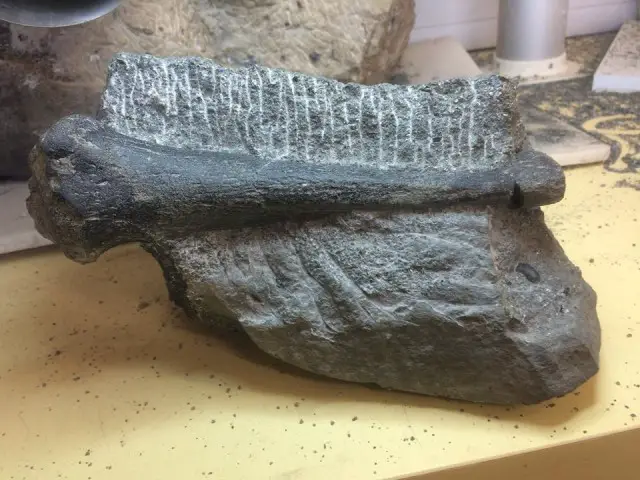Great news from Dinosaur Isle with another rare fossil find. Ed
New remains of what may be the oldest marine reptile to have been found on the Isle of Wight have just gone on display at Dinosaur Isle, Sandown.
Possibly over 150 million years old
The paddle bone; a femur, belongs to a large predatory reptile that would have been swimming in seas that formed over the Island millions of years ago.
The bone has been identified by experts from the museum as belonging to a Plesiosaur, and closest resembles a Colymbosaurus, an animal that would have been similar in appearance to the Loch Ness monster, and swam the seas in the Jurassic period over 150 million years ago.
Discovered in Yaverland
The bone was found at Yaverland Beach by a member of staff at Dinosaur Isle, Alex Peaker. Only a small part of the bone was exposed and took staff several days to remove the rock that encased the bone so that it could be identified.
It is now on display with other fossils from the Island seas at Dinosaur Isle.
Marine reptile remains rarely found
Alex Peaker, assistant community learning officer at Dinosaur Isle, who found the bone, said:
“The animal appears to have been a juvenile when it died and would have only been around four metres in length, but when fully grown it could have reached lengths of almost ten metres.
“A combination of the age and type of rocks that are exposed on the Island mean that marine reptile remains such as Plesiosaurs are rarely found. Across the Island the oldest rocks that we have exposed are from the Lower Cretaceous, and are about 125 million years old, but we believe that this fossil may be much older.”
A hidden treasure
Commenting on the find, Richard Smout, Isle of Wight council heritage service manager said:
“Thanks to the eagle eyes of Alex and the team’s perseverance in painstakingly uncovering this hidden treasure, we now have an extremely rare find to display in our much loved Dinosaur Isle, just, in time for the Easter half term.
“I really recommend a visit as you will see dinosaur skeletons as they are found by the fossil hunters and can watch our volunteers preparing the latest exciting finds, as well as having the chance to view this latest extremely rare find.”
The oldest rocks exposed on the Island are from the Cretaceous period and date back to the Cretaceous period approximately 125 million years ago, but some of these rocks are known to contain much older fossils.
During a period when the seas were encroaching on the land of the Island a large Jurassic escarpment had formed, allowing fossils that had formed 25 million years beforehand to be eroded out of their Jurassic rocks and deposited into the younger Cretaceous rocks.
It is believed that the new find is one of these much older fossils.
Image: © Dinosaur Isle





